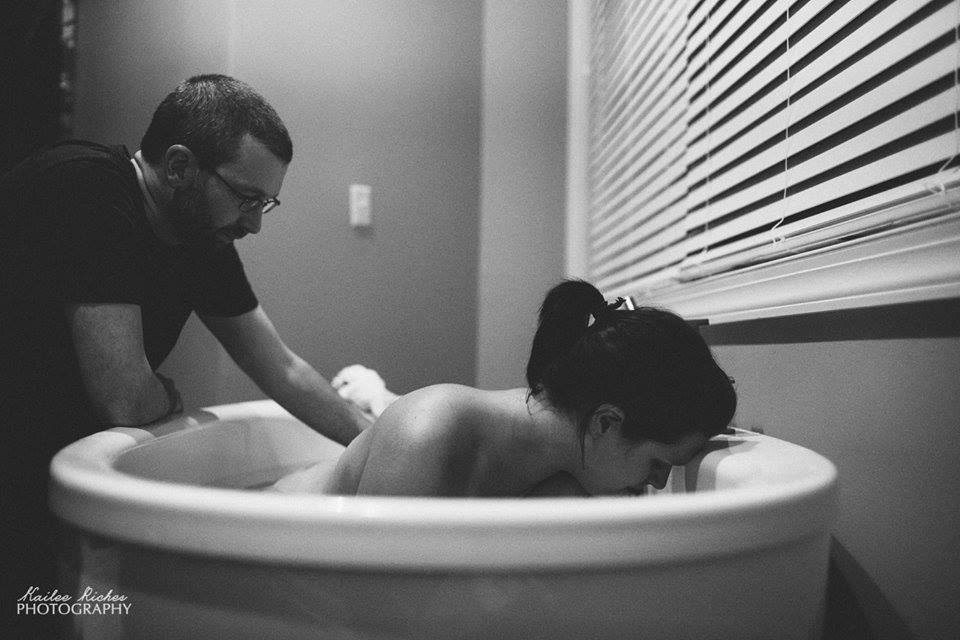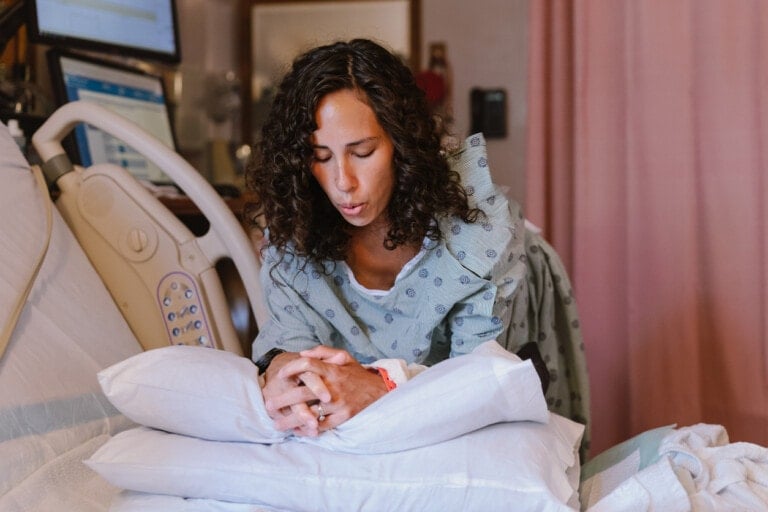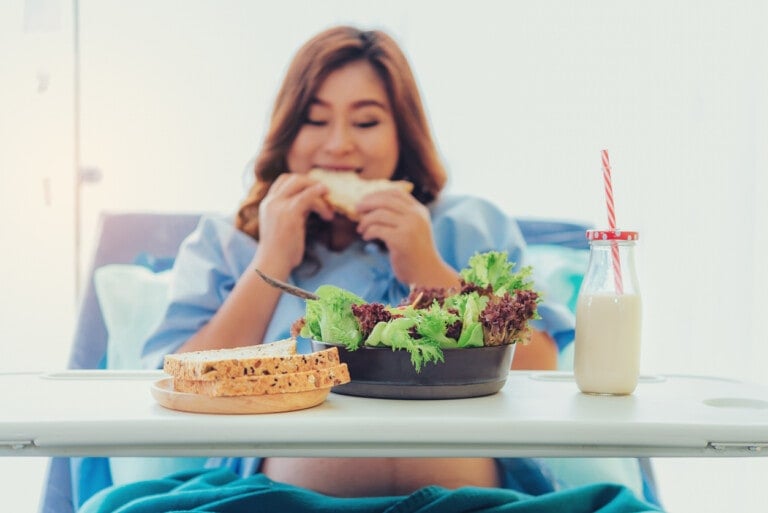You’ve gotten through early labor and active labor, and things are getting intense. If you haven’t gotten an epidural by now, this is probably the time you may start wanting one. And if you want to have a natural birth, I know you can do it! You can get through transition labor! To help you through this phase and get you to pushing baby out, I’ve listed six tips below, along with some partner tips. But first, let’s answer some common questions.
What Is Transition Labor?
Transition is the last (and most difficult) phase of labor. Luckily, it is also the shortest phase of labor. In this phase, your cervix will dilate from 7 to 10 centimeters (complete) and be completely effaced.1,3 Your contractions will be about two to three minutes apart, last for 60–90 seconds, and feel strong in intensity.2,4 Because of the speed and intensity, this is when your focus might falter. Your contractions may even come back-to-back, one right after the other.2 With this intensity, you may doubt your ability to birth your baby naturally and start requesting medications.
This is all normal, but you can do it! It’s also normal to start worrying about how long your labor will last and how much more intense things will get. This can discourage women, and it’s why birth partners must be by your side, providing you with physical and emotional support. They should be your voice of reason when you doubt yourself and when the medical staff starts offering medication. (Partners, if you are not confident being in this primary supporting role, you should look into hiring a doula.)
What You May Feel During Transition
Here are some of the symptoms you may experience during transition labor:1,2,3,4,5,13,14,15,16
- Contractions that are longer and more intense
- Nausea (vomiting or having dry heaves)
- Burping and/or hiccups
- Time distortion
- Leg cramps
- Hot/cold flashes (sweating and going from hot to cold)
- Trembling and uncontrollable shaking
- Intense perineal/rectal pressure (feeling like you need to have a bowel movement)
- Rupture of membranes and increase in bloody show
- Loss of modesty
- Loss of appetite
- Irritability (feeling overwhelmed after coping well with active labor; announcing you can’t do it anymore, want to go home, or want drugs)
- Loss of resolve
- Need for physical and emotional support
- Increased sensitivity to touch
- Feeling exhausted, foggy, and out of control
- Averse to distractions
- Disoriented
- Self-doubt
How Long Does Transition Last?
As I mentioned earlier, transition is the shortest phase in labor. It generally lasts about a half hour to two hours or, at most, three hours.1,3 You are so close, mama. You can do it!
6 Tips on What To Do During Transition Labor
Now that you know what to expect from transition, here are six tips to help you get through it and be able to start pushing!
1. Get in the Water
Water is nature’s epidural. I can’t tell you how often my clients have refused to get out of the water during labor, and I have to remind them that since they have chosen a hospital birth, they have to get out of the tub. Birth center births and home births do not have this issue since their care providers are midwives. Still, unfortunately, most doctors in hospitals will not allow you to have a water birth because they do not have the training to catch a baby in the water. Although, if you have your baby in a hospital, it doesn’t mean you can’t be in the water during transition; it just means you can’t be in the water while pushing.
Being fully submerged in the water (especially during transition) is one of the most (if not the most) relaxing places to be during labor. Getting in the water will help you relax your muscle, enabling your body to open up and push your baby further down into your pelvis to get ready for pushing.8 Get. In. The. Water. You won’t regret it.
2. Focus On Your Breathing
You have probably been focusing on your breathing all along, which is good! But during transition, it requires your full attention. It may sound like a simple task to focus on breathing in and out, but it takes enormous effort and commitment to keep your attention on it when things get tough. During labor, most women I am with appreciate reminders to slow their breathing, relax their jaw, take a big inhale, and let out a long exhale. The less tense you are, the better! And well-paced breathing can help with that.9
3. Make Sounds During Contractions
Some women may feel they need to be quiet during labor, or else they are making a scene. Please erase that from your mind because making sounds during your contractions is normal and helpful. During labor, the sounds you make should always be low-moaning sounds. Those low sounds relax your mouth and throat, which helps relax your cervix and vagina.10 (If you think about when you orgasm, your mouth is open, and you breathe deeply. We need you to do the same thing during labor to help open everything up to give birth to your baby. Like I tell my laboring mamas, open mouth = open vagina.)
4. Change Positions
Moving during this phase can be incredibly exhausting, but the more you move to help open your pelvis, the faster this phase will go.11 Hands and knees is a popular position to do during transition labor. This is because it removes the pressure from your back and allows your support person to massage you, put a warm compress on your lower back, or do counter-pressure to relieve that pressure and pain.11
5. Let Go
Women who have the quickest labor are often the ones who completely let go and follow their body’s lead. They realize that everything in labor is beyond their control and that they must relax and surrender to all the sensations. Your job is to accept and work with the urges that are bringing your baby to you.
In transition, a new sensation you will feel is rectal pressure.1,2 Some women tense and clench their bottoms with this intense sensation, but your body needs to relax and allow things to open.12 The more you do that, the sooner the pressure will be constant, and you will be ready to push.
6. Ask For Help
Most women say they couldn’t have gotten through labor without their partner. They often say their partner kept them focused and gave them a sense of security. So even if you don’t know what you want, ask for help. Let your partner and support people know they need to do more to help.
Partner Tips During Transition
Be Positive, Stay Close, and Talk to Her
Partners should remain with you and give short, clear, positive, and simple directions. Phrases they might say include:
- “Breathe in. Exhale down your body.”
- “Relax your shoulders, relax your jaw, and take a deep breath.”
- “Take a sip of water before the next contraction.”
- “You’re doing it. You’re doing great.”
- “I’m so proud of you.”
- “Let’s move to hands and knees.”
- “You’re safe.”
- “You’re almost there.”
- “I love you.”
- “You’re so close to having our baby.”
Your partner needs to be by your side and your upper body so that you can feel their presence, hear their voice, and even look into their eyes. These things will encourage you to continue. Read these tips for dads during labor and delivery for more ideas on how your partner can help.
Help Her Move
Moving can be challenging for a laboring woman during transition labor. Your partner should help you with changing positions and help you continue your movement. They can support you while you’re standing and even slow dance with you, allowing you to give all your weight to them to relax fully.
Keep Her Cool
You have been working so hard during labor that you may become very warm during transition. Your partner can give you some relief by fanning you down or wiping your brow, neck, and face with a cool washcloth. They should leave the cool washcloth on your forehead, but they must remember to exchange it occasionally for a cool, fresh one. They should be reminding you to stay hydrated and drink water between contractions.
Get the Water Ready
If you are interested in getting in the water (which you should if you have made it this far without pain medications), your birth partner should help you get the shower turned on or the bathwater running so that the temperature will be just right when you get in. No one wants a cold shower or lukewarm bath when in transition.
Don’t Take Things Personally
Labor, in general, is hard work, but transition labor can be the toughest.1 If you are short and rude to your birth partner, they must know not to take it personally. You chose them to help you during this intense yet exciting time because you love and/or trust them. They are a safe outlet, and they must remember you are hormonal, tired, and going through a lot, so they should not take anything you say personally.
Hold Her and Touch Her
Some women prefer less or no touch at this point in labor. Others need constant touch at this time. A massage is usually a helpful tool, but counter-pressure is always welcomed if that is too much stimulation.6 Even if your partner just holds your hand, it will make you feel loved and supported.
Recognize Her Work
When you are in transition, you must be reminded that you have reached this point. Realizing this phase is almost complete will help you handle it more comfortably. Your partner should remind you that you are near the end and that each contraction is one step closer to holding your child. This can be a huge motivator!
Be Her Advocate
Unfortunately, transition is usually when an unsupportive care provider may undermine the efforts of natural birth. They may suggest or attempt unnecessary interventions without your consent since your ability to make decisions and verbalize your wishes is limited in this phase.7 Your birth partner is essential at this time, and they need to act as your advocate and speak for you when you cannot.
While you don’t know what your transition will be like, you (and your partner) can now be ready for the challenges it may bring. Above all, remember transition is only a small part of your birth. It is the fastest part of labor, and the next stage, pushing, should be better. All in all, I want you to know you can do it. 🙂































